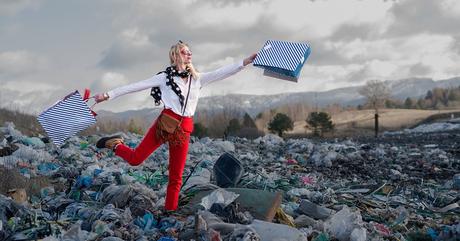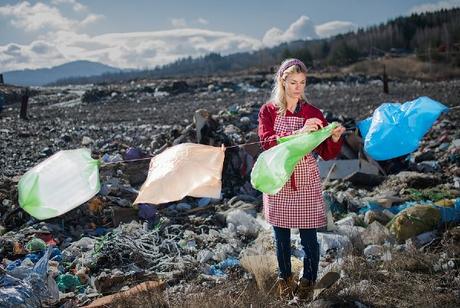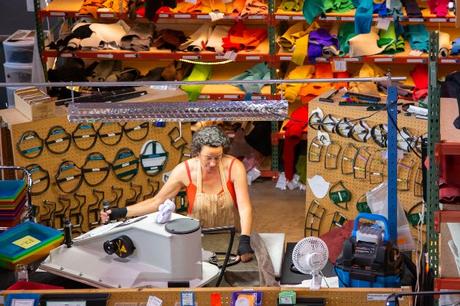
Americans send 22 billion pounds of apparel to landfills each year-an average of 82 pounds of textile garbage per American per year. [1] Despite good trends in clothing recycling and resale, the majority of the 184 billion pounds of clothing made globally each year ends up in a landfill. [5] Some of the waste is used clothing, but the majority is waste from overproduction of apparel that never sells. Instead, it is sent to landfills by the vendors who cannot sell the extra garments and odd sizes. To put that in perspective, that is approximately 14 great pyramids of textile trash each year. Over half of these textiles are polyester - a kind of plastic which does not decompose and pollutes soil and ground water with plastic microfibers. [6]
 The amount of textile trash put into landfills each year is equal in size to 14 Great Pyramids
The amount of textile trash put into landfills each year is equal in size to 14 Great Pyramids The Culprit: Fast Fashion and Mass Production
Fast fashion is an overarching term describing companies that follow the latest fashion trends, mass produce apparel following said trends, and get them into stores as fast as possible while the trend is still relevant. Rather than a few fashion seasons a year, fast fashion brands may produce a new style portfolio each week. They use cheap, non-durable textiles and fast, low-quality construction. The lower prices encourage increased buying. Some products are so over produced (or ugly) that once the trend has passed, even the steepest discount can't wipe out a company's inventory. This forces companies to have to decide how to get rid of excess product. Here are a few of their options:
- Let it sit in inventory and take up valuable space (expensive)
- Ship it to a landfill
- Send it to an incineration plant and contribute to the approximately 1 billion tons of waste being burned globally every year, releasing harmful global emissions [2]
- Donate it to charities and those in need
- Recycle it (shred it up and reuse the fibers)
- Re-sell it, but the value is not usually there for cheaper fast fashion items
Most companies usually go with option 2 or 3 due to fears of products being stolen, replicated poorly, and sold for lower prices, tarnishing the brand's identity and reputation.
A finished product itself is not the only thing that goes to waste when excess is made. It's also the raw materials, packaging, and the means of getting materials and product where it needs to be. When a company manufactures too much product, that's just that much more material, fuel, time, money, and products that go to waste without ever being touched by a consumer. Feels silly, right?

If Mass Production is Bad, Why Do It?
It's important to understand that for several businesses, mass production is extremely attractive due to its efficiency. The larger quantity produced, the cheaper the product is to make. When having a strong bottom line is the company's main goal, mass production is an obvious choice. Some companies, like Softstar, adopt a triple bottom line framework and consider social and environmental impacts to be equally important, with a commitment to long-term value for our society.
There is also psychological component of why fast fashion exists. The world of stuff is constantly being pushed and pulled by consumers' demand for the latest trend, and the desire for instant gratification. Fast fashion companies can satisfy this demand by making everything in excess ahead of the demand, allowing the item to get in the consumer's hands almost immediately.
Is There a Solution?
So, how is this problem minimized? To some extent, the power of supply and demand is strong; if consumers adopt a more sustainable, less materialistic mindset, then demand for useless, excess product will be reduced, thus reducing supply as well. However, there are still situations where companies miscalculate expected sales for their exciting new product. Or they deem the efficiency benefits of mass production extremely beneficial for one reason or another. Admittedly, calculating how much stock to make based on future demand is extremely difficult. While there is not one right answer and solutions to decreasing overall waste around the globe can be discussed extensively, there remains another solution: made-to-order production.
What is Made-to-Order Production?
Made-to-order production can be described as waiting to manufacture a particular product until an actual order is made for it. Consider a time when you decide to go buy a pizza for dinner. You have two options: you can go to the grocery store and pick out a boxed pizza in the frozen isle, or you could go to a local pizza place, place an custom order, and have them make your pizza fresh, just how you want it. In this case, ordering from the local pizza place can be an example of made-to-order production; your pizza would not have been made if you hadn't ordered it (and thus the ingredients would have been saved for someone who did place an order), but the frozen pizzas in the grocery store would still be made and sitting in the freezer regardless of your choice.

Softstar's are Made to Last
Instead of basing our production on chasing the latest trend, Softstar designs classic styles that
stick around for many years. In addition, Softstar uses a uses made-to-order production model. The elves generally do not make shoes until there is an order, therefore avoiding excess waste. The order could come directly from the customer in the form of custom colors, or it could be an internal Kanban order to replace a popular size 7W black shoe. By not having to focus on making a large quantity of items quickly and cheaply, we can actually focus on creating quality goods exactly for the people who want them.
When we receive your orders, we print your order form, handcraft your shoe just how you want it, and send it off. In contrast, for shoe companies that use mass production, tens of thousands of shoes are made in each color and size combination in advance and stuck in a warehouse with no guarantee that they will receive the orders needed to sell them all.
Softstar also works hard to find homes for shoes that are returned or can't be sold due to quality issues. We encourage resale sites, donate shoes to families in need, and have clearance pricing to help each and every pair find a good home.

Why Should I Care?
As the negative environmental impacts caused by waste escalate by the day, we believe that we all need to begin making sustainable changes in our lives in any way that we can. Consuming less, being mindful of waste, and choosing to support companies that have implemented environmentally-friendly practices are all great places to start. By supporting an item from a company that uses made-to-order production, you are directly making a difference in reducing waste. You are buying a product that will be made specifically for you without a copious volume of the exact same unit being made in addition. Not to mention, having a product that is made uniquely just for you feels pretty special, too! Being mindful of the products you are consuming, as well as the waste you are contributing, is a great way to incorporate sustainability into your everyday life.
References
- Textiles: Material-Specific Data
- Science Daily: Trash Burning Worldwide Significantly Worsens Air Pollution
- What Stores Don't Sell
- How Much Would It Cost to Build the Great Pyramid Today?
- 10 Stunning Fast Fashion Waste Statistics
- Preference for Polyester May Make Fast Fashion Brands Vulnerable

